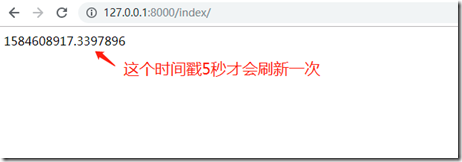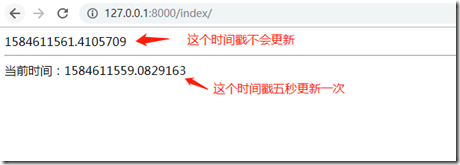1、缓存介绍
在动态网站中,用户所有的请求,服务器都会去数据库中进行相应的增,删,查,改,渲染模板,执行业务逻辑,最后生成用户看到的页面.
当一个网站的用户访问量很大的时候,每一次的的后台操作,都会消耗很多的服务端资源,所以必须使用缓存来减轻后端服务器的压力.
缓存是将一些常用的数据保存内存或者memcache中,在一定的时间内有人来访问这些数据时,则不再去执行数据库及渲染等操作,
而是直接从内存或memcache的缓存中去取得数据,然后返回给用户.2、Django中的6种缓存方式
1)开发调试(此模式为开发调试使用,实际上不执行任何操作)
settings.py文件配置
CACHES = { 'default': { 'BACKEND': 'django.core.cache.backends.dummy.DummyCache', # 缓存后台使用的引擎 'TIMEOUT': 300, # 缓存超时时间(默认300秒,None表示永不过期,0表示立即过期) 'OPTIONS':{ 'MAX_ENTRIES': 300, # 最大缓存记录的数量(默认300) 'CULL_FREQUENCY': 3, # 缓存到达最大个数之后,剔除缓存个数的比例,即:1/CULL_FREQUENCY(默认3) }, } }
2)内存缓存(将缓存内容保存至内存区域中)
settings.py文件配置
CACHES = { 'default': { 'BACKEND': 'django.core.cache.backends.locmem.LocMemCache', # 指定缓存使用的引擎 'LOCATION': 'unique-snowflake', # 写在内存中的变量的唯一值 'TIMEOUT':300, # 缓存超时时间(默认为300秒,None表示永不过期) 'OPTIONS':{ 'MAX_ENTRIES': 300, # 最大缓存记录的数量(默认300) 'CULL_FREQUENCY': 3, # 缓存到达最大个数之后,剔除缓存个数的比例,即:1/CULL_FREQUENCY(默认3) } } }
3)文件缓存(把缓存数据存储在文件中)
settings.py文件配置
CACHES = { 'default': { 'BACKEND': 'django.core.cache.backends.filebased.FileBasedCache', #指定缓存使用的引擎 'LOCATION': '/var/tmp/django_cache', #指定缓存的路径 # 'LOCATION': r'D:�0000cache', #windows指定缓存的路径 'TIMEOUT':300, #缓存超时时间(默认为300秒,None表示永不过期) 'OPTIONS':{ 'MAX_ENTRIES': 300, # 最大缓存记录的数量(默认300) 'CULL_FREQUENCY': 3, # 缓存到达最大个数之后,剔除缓存个数的比例,即:1/CULL_FREQUENCY(默认3) } } }
4)数据库缓存(把缓存数据存储在数据库中)
settings.py文件配置
CACHES = { 'default': { 'BACKEND': 'django.core.cache.backends.db.DatabaseCache', # 指定缓存使用的引擎 'LOCATION': 'cache_table', # 数据库表 'OPTIONS':{ 'MAX_ENTRIES': 300, # 最大缓存记录的数量(默认300) 'CULL_FREQUENCY': 3, # 缓存到达最大个数之后,剔除缓存个数的比例,即:1/CULL_FREQUENCY(默认3) } } }
注意,创建缓存的数据库表使用的语句:
python manage.py createcachetable
5)Memcache缓存(使用python-memcached模块连接memcache)
Memcached是Django原生支持的缓存系统.要使用Memcached,需要下载Memcached的支持库python-memcached或pylibmc.
settings.py文件配置
CACHES = { 'default': { 'BACKEND': 'django.core.cache.backends.memcached.MemcachedCache', # 指定缓存使用的引擎 'LOCATION': '192.168.10.100:11211', # 指定Memcache缓存服务器的IP地址和端口 'OPTIONS':{ 'MAX_ENTRIES': 300, # 最大缓存记录的数量(默认300) 'CULL_FREQUENCY': 3, # 缓存到达最大个数之后,剔除缓存个数的比例,即:1/CULL_FREQUENCY(默认3) } } }
LOCATION也可以配置成如下:
'LOCATION': 'unix:/tmp/memcached.sock', # 指定局域网内的主机名加socket套接字为Memcache缓存服务器 'LOCATION': [ # 指定一台或多台其他主机ip地址加端口为Memcache缓存服务器 '192.168.10.100:11211', '192.168.10.101:11211', '192.168.10.102:11211', ]
6)Memcache缓存(使用pylibmc模块连接memcache)
settings.py文件配置
CACHES = { 'default': { 'BACKEND': 'django.core.cache.backends.memcached.PyLibMCCache', # 指定缓存使用的引擎 'LOCATION':'192.168.10.100:11211', # 指定本机的11211端口为Memcache缓存服务器 'OPTIONS':{ 'MAX_ENTRIES': 300, # 最大缓存记录的数量(默认300) 'CULL_FREQUENCY': 3, # 缓存到达最大个数之后,剔除缓存个数的比例,即:1/CULL_FREQUENCY(默认3) }, } }
LOCATION也可以配置成如下:
'LOCATION': '/tmp/memcached.sock', # 指定某个路径为缓存目录 'LOCATION': [ # 分布式缓存,在多台服务器上运行Memcached进程,程序会把多台服务器当作一个单独的缓存,而不会在每台服务器上复制缓存值 '192.168.10.100:11211', '192.168.10.101:11211', '192.168.10.102:11211', ]
Memcached是基于内存的缓存,数据存储在内存中.所以如果服务器死机的话,数据就会丢失,所以Memcached一般与其他缓存配合使用;
3、Django中单页面使用缓存
Django提供了不同粒度的缓存,可以缓存某个页面,可以只缓存一个页面的某个部分,甚至可以缓存整个网站.
settings.py
CACHES = { 'default': { 'BACKEND': 'django.core.cache.backends.filebased.FileBasedCache', #指定缓存使用的引擎 'LOCATION':r'D:�0000cache', #指定缓存的路径 'TIMEOUT':300, #缓存超时时间(默认为300秒,None表示永不过期) 'OPTIONS':{ 'MAX_ENTRIES': 300, # 最大缓存记录的数量(默认300) 'CULL_FREQUENCY': 3, # 缓存到达最大个数之后,剔除缓存个数的比例,即:1/CULL_FREQUENCY(默认3) } } }
views.py
from django.shortcuts import render import time from django.views.decorators.cache import cache_page # Create your views here. @cache_page(5) # 使用装饰器,5:代指缓存时间(s) def index(request): ctime = time.time() return render(request, 'index.html', {'time': ctime})
index.py
<!DOCTYPE html> <html lang="en"> <head> <meta charset="UTF-8"> <title>Title</title> </head> <body> {{ time }} </body> </html>
urls.py
from django.conf.urls import url from django.contrib import admin from app01 import views urlpatterns = [ url(r'^admin/', admin.site.urls), url(r'^index/', views.index), ]
4、页面中的局部缓存
我们不想把整个页面全都缓存,只想缓存页面中的一部分;
views.py
from django.shortcuts import render import time def index(request): ctime = time.time() return render(request, 'index.html', {'time': ctime})
index.html
<!--先load--> {% load cache %} <!DOCTYPE html> <html lang="en"> <head> <meta charset="UTF-8"> <title>Title</title> </head> <body> {{ time }} <br> <!--然后把需要缓存的部分包括起来--> <!--5:缓存时间; test: key值--> {% cache 5 'test'%} 当前时间:{{ time }} {% endcache %} </body> </html>
5、全站缓存
既然是全站缓存,当然要使用Django中的中间件;
用户的请求通过中间件,经过一系列的认证等操作,如果请求的内容在缓存中存在,则使用FetchFromCacheMiddleware(必须在最后)获取内容并返回给用户;
当返回给用户之前,判断缓存中是否已经存在,如果不存在,则UpdateCacheMiddleware会将缓存保存至Django(必须在最前)的缓存之中,以实现全站缓存;在 MIDDLEWARE_CLASSES 中加入 “update” 和 “fetch” 中间件:
settings.py
MIDDLEWARE = [ 'django.middleware.cache.UpdateCacheMiddleware', # 放在第一个 'django.middleware.security.SecurityMiddleware', 'django.contrib.sessions.middleware.SessionMiddleware', 'django.middleware.common.CommonMiddleware', 'django.middleware.csrf.CsrfViewMiddleware', 'django.contrib.auth.middleware.AuthenticationMiddleware', 'django.contrib.messages.middleware.MessageMiddleware', 'django.middleware.clickjacking.XFrameOptionsMiddleware', 'django.middleware.cache.FetchFromCacheMiddleware', # 放在最后 ]
还要在settings.py中加入超时时间:
CACHE_MIDDLEWARE_SECONDS=5 #超时时间5秒
写两个测试页面:
index.html
<!DOCTYPE html> <html lang="en"> <head> <meta charset="UTF-8"> <title>Title</title> </head> <body> {{ time }} <hr> 当前时间:{{ time }} </body> </html>
home.html
<!DOCTYPE html> <html lang="en"> <head> <meta charset="UTF-8"> <title>Title</title> </head> <body> {{ time }} <hr> 当前时间:{{ time }} </body> </html>
urls.py
from django.shortcuts import render import time def index(request): ctime = time.time() return render(request, 'index.html', {'time': ctime}) def home(request): ctime = time.time() return render(request, 'home.html', {'time': ctime})
urls.py
from django.conf.urls import url from django.contrib import admin from app01 import views urlpatterns = [ url(r'^admin/', admin.site.urls), url(r'^index/', views.index), url(r'^home/', views.home), ]
此时点击刷新两个页面,发现时间戳都要等待5秒才能刷新;
6、扩展
在前后端分离项目中的缓存:
# 设置缓存和取值,test_data是key,{'name':'w', 'age':20}是要缓存的值,5是超时时间 cache.set('test_data', {'name':'w', 'age':20}, 5) cache.get('test_data')

